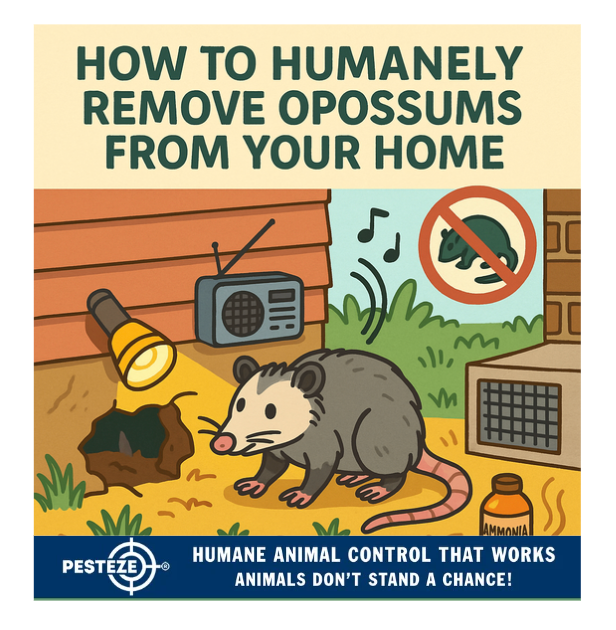HOW TO HUMANELY REMOVE OPOSSUMS FROM YOUR HOME

HOW TO HUMANELY REMOVE OPOSSUMS FROM YOUR HOME
SUMMARY
This guide outlines safe and humane methods for removing opossums from your home. Learn how to identify their entry points, use gentle eviction techniques, and prevent future invasions without causing harm to these beneficial wildlife creatures.
FEATURES
-
Identify Signs: Look for droppings, noises, and disturbed insulation.
-
Encourage Exit: Use light, sound, or scent deterrents to guide them out.
-
Seal Entry Points: Close off openings after confirming the opossum has left.
-
Avoid Direct Contact: Never corner or handle wild opossums.
-
Call Professionals: Contact wildlife experts for safe removal if needed.
-
Prevent Return: Maintain clean surroundings and secure garbage.
GUIDE DESCRIPTION
Opossums are generally gentle, solitary animals that often enter homes seeking warmth, shelter, or food. While their presence can be unsettling, it’s important to remember that they play a valuable ecological role by eating pests like ticks, snakes, and insects. The goal is to remove them safely and humanely while preventing future intrusions.
Start by identifying signs of an opossum’s presence. Common indicators include scratching or rustling sounds at night, droppings, or strong odors from urine. They typically enter through broken vents, open crawl spaces, or gaps under decks and porches. Use a flashlight to inspect your attic, basement, or crawl space — but do not approach or attempt to handle the animal. Opossums are non-aggressive but may hiss or show teeth if frightened.
Once confirmed, focus on encouraging the opossum to leave naturally. These nocturnal creatures prefer dark, quiet spaces, so making their shelter less appealing is key. Bright lights, portable radios, or ultrasonic deterrents can gently drive them out. Place ammonia-soaked rags or vinegar near their den (avoiding direct contact), as the smell is unpleasant to them. Always provide an exit route, such as an open door or vent, so the animal can leave on its own during the night.
After you are sure the opossum has exited — typically within a day or two — it’s time to seal up any entry points. Repair broken screens, close gaps around foundations, and cover vents with metal mesh. If you’re unsure whether the opossum is gone, sprinkle flour near the opening and check for fresh tracks before sealing.
If an opossum appears injured, trapped, or refuses to leave, contact local animal control or a licensed wildlife rehabilitator for professional assistance. Trapping should only be used as a last resort and must follow local wildlife regulations. Never attempt to relocate an opossum on your own, as it can lead to stress, dehydration, or death.
To prevent future visits, keep outdoor trash cans sealed, remove fallen fruit, and eliminate pet food left outside overnight. Regularly inspect your home’s exterior for gaps or weak spots that could serve as new entry points.
By using these humane methods, you can safely remove opossums from your property while respecting their role in maintaining ecological balance.
- Saneeth Thota


Comments 0